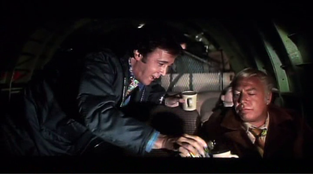Lost Horizon (1973)
- nickkarner
- Apr 21, 2021
- 16 min read

“Those who do not learn history are doomed to repeat it.” -George Santayana, writer and philosopher, 1905.
After the insanity of the Taylor-Burton-Harrison production of Cleopatra (1963), 20th Century Fox was practically at death’s door. If not for the international intrigue surrounding the illicit affair between Elizabeth Taylor and Richard Burton, the over-budget historical epic may well have sunk one of the original Hollywood studios. Without the massive public interest in seeing the romance between these two movie stars play out onscreen, Joseph L. Mankiewicz’s near career-destroying folly would’ve bankrupt Fox and the film would either be remembered as one of those extravagant Cinemascope affairs which destroyed a studio (an event 1980's Heaven’s Gate is inaccurately credited with), or merely a footnote in cinematic history as Hollywood continued its losing battle against its arch-nemesis: television.

What could possibly save 20th Century Fox? Singing and dancing Nazis, of course! Well, not exactly, but it’s fun to say nonetheless. Yes, Robert Wise’s massively successful (and family-friendly) musical The Sound of Music (1965) swooped in like a long crane shot over a mountain-side vista and saved the studio from financial ruin. Of course, any time something in Hollywood makes money, you can expect a bevy of imitators, often producing less-than thrilling results. Paint Your Wagon, Dr. Dolittle, Hello, Dolly!, Star!, On a Clear Day You Can See Forever, and Half a Sixpence proved that bigger is definitely not better.

By 1970, Ross Hunter (real name Martin Fuss) had made a successful transition from actor to big shot producer, with his crowning achievement being the Oscar-winning Airport (1970). Prior to this, he produced classy weepies like Douglas Sirk’s Magnificent Obsession, All That Heaven Allows, and Imitation of Life, or light romantic comedies like Pillow Talk and Tammy and the Bachelor. In 1973, he went for broke with his musical adaptation of a 1933 novel by James Hilton...and this time, the flop monster who nearly caught Cleopatra in its neon claws took a firm grip on Lost Horizon and refused to let go.

Of course, if it weren’t for the hubris of the powers-that-be, this bloated slog of a musical would never have made it past a drunken, drug-fueled riff at a swanky party in the Hollywood Hills had they double-checked their history books. Frank Capra’s sweet but problematic 1937 film was a big hit for Columbia, but due to its huge (in those days) budget of nearly 2 million dollars, it wouldn’t fully recoup its investment until nearly five years later while in re-release. Money aside, the original film’s rocky post-production, which involved a disastrous preview, the intentional destruction of irreplaceable footage, and an angry studio head (Harry Cohn) hacking away at a film which ran well over three hours, reveals the fundamental difficulties in bringing Hilton’s characters to life.

Nearly 20 years later, the Winter Garden Theatre welcomed, then quickly bid adieu, to Shangri-La (1956), a Broadway musical which closed after only 21 performances. Critics praised the costumes, a few of the actors, but mainly the mountainous set by Peter Larkin, which featured a tilted, translucent floor through which colored lights shone through. The main problem most theatregoers had with Shangri-La was its similarity to Brigadoon (1954), a much more successful show which also featured a mysterious and magical place. I myself have a great fondness for Brigadoon due to my history with it. My sister did it in high school, I performed “Almost Like Being in Love” for a talent show (I lost to a little girl who sang “Part of your World,” cough ‘popularity contest’ cough), and I ended up being the dance captain and semi-tragic Harry Beaton (Master Beaton, some cast members said, much to my chagrin. Say it with a Scottish accent, you’ll see) in a community theatre production. Brigadoon the stage show featured amazing choreography, a lovely score, and a ludicrous story that still tugged at the heartstrings.
While the 1954 movie version lacks a certain flair, it at least featured a genius musical performer like Gene Kelly who could wow audiences with his triple-threat abilities. As far as a musical theatre pedigree goes, Lost Horizon doesn’t exactly feature a gaggle of hoofers and troubadours and its historic failure would serve as a death knell for the movie musical. Sgt. Pepper’s Lonely Hearts Club Band, Sextette, The Wiz, Mame, At Long Last Love, and (sadly) A Little Night Music effectively killed the genre until megahit Grease (1978) brought it roaring back, albeit briefly.

Musicals are a highly divisive movie and theatre genre. Some find it charming and whimsical when characters burst into song when regular talk won’t suffice. Others regard splashy production numbers as schmaltzy, insipid, or just plain bad. There’s a reason studios tend to downplay the ‘musical’ aspects of a movie musical. The disastrous Quvenzhané Wallis-starrer Annie (2014) didn’t even feature any singing in its early trailers. A friend of mine went to Dreamgirls (2006) and left after 10 minutes when he figured out it was a musical. Idiot. While I don’t disagree with the idea of musicalizing Lost Horizon, the creative team tasked with composing the score happened to be at a bitter crossroads around the time of production. Couple that with actors who weren’t known for their musical chops and you’ve got the recipe for a truly awful musical extravaganza. Stephen Sondheim has often stated that he prefers “actors who sing” as opposed to “singers who act” because actors can interpret the emotional resonance in his lyrics to a degree classically-trained singers simply can’t. That’s all well and good, but still...it’s nice when the performers in question at least sound good.

By the mid-1960's, the civil rights movement valiantly fought for equality and against racial injustice. Antiwar protests continued to grow against the U.S. involvement in the Vietnam War and the space race was in full, bitter swing against those pesky Russians. It was a tumultuous time for America, but one particular musical duo was determined to deliver gentle, soothing pop tunes for an ailing nation. The collaborations between composer Burt Bacharach and lyricist Hal David resulted in bouncy, infectiously catchy tunes like “Walk on By,” “Wishin’ and Hopin’,” “I Say a Little Prayer for You,” and the hit musical Promises, Promises (1968). While their story does have a happy ending, with a triumphant reconciliation in 1993 as they were given the ASCAP Founders Award; by 1973, the duo had already bought a one-way ticket to Splitsville, in separate train cars, no less.

Whenever a film is a success, there’s an onslaught of shoving and jockeying for attention as the various people with even a tangential connection to the movie try to take credit for the big box office numbers or multiple Oscar wins. I’m reminded of a wonderful Mr. Show sketch in which an advertising firm wins an award for an uplifting ad about NAMBLA and two out of the three “Mad Men” refuse to take credit. The one who does is chased out of the studio, Frankenstein-style, by an angry mob with pitchforks and torches. The team behind Promises, Promises, which was ironically given a 2010 revival thanks to AMC’s hit show, stated in a 2010 interview that: "The score (for Lost Horizon) is a very good piece of work, but the movie just didn't work." Conversely, in 1975, Ross Hunter told Rona Barrett that pre-production was already underway when he received the 11 original Bacharach-David tunes. He claimed: “We knew it was a bum score, but we couldn't do anything about it." It’s difficult to pinpoint whether an issue involving Bacharach and David’s frequent songstress Dionne Warwick was to blame for their break-up or whether Bacharach (a noted perfectionist) railed against the production for being locked out of the editing suite and felt Hal David wasn’t supportive enough of his writing partner's protests. Either way, the names Ross Hunter, Burt Bacharach, and Hal David are prominently featured in the film’s languid, sleep-inducing opening credits sequence, so the creators obviously decided: This movie may be crap, but it’s our crap.

Screenwriter Larry Kramer may be best known for his tireless efforts raising awareness during the AIDS crisis of the 1980’s, most notably with his groundbreaking play The Normal Heart, but he dipped his toe into the flickers a couple of times. His adaptation of D.H. Lawrence’s Women in Love (1969) garnered an Oscar nomination and allowed Ken Russell to make arguably the classiest (and most restrained) film he ever directed. There’s a reason James Hilton’s novel was a best-seller. The story itself is intriguing. A group of people brought together by chance are kidnapped, so to speak, and brought to Shangri-La, a land where the sun always shines and no one grows old. A great deal of plot and even dialogue is lifted from the book and the Capra-version, and although the entire film devolves into a brutally boring slog, the first 45 minutes (basically before any real musical numbers rear their tacky heads) are mildly interesting.

English director Charles Jarrott brings an old-fashioned sensibility to the production which likely pleased Ross Hunter but alienated most mainstream audiences of the early 70’s, who had moved on to the harder stuff like Klute (1971) and Deliverance (1972). His breakthrough film came in 1969 with the Oscar-winning Anne of the Thousand Days, which allowed him to move out of television and into full-time feature filmmaking. His work throughout the 70’s was never particularly unique, but it featured solid, well-regarded films like Mary, Queen of Scots, The Dove, and The Other Side of Midnight. He’d hook up with Disney during its declining years following Walt Disney’s death, delivering The Littlest Horse Thieves, The Last Flight of Noah’s Ark, and the forgotten superhero film Condorman. He’d attempt one more feature with the obscure Canadian film The Boy in Blue (1986), featuring an early Nicolas Cage performance, before returning to television and ending his career with a couple of unmemorable features.

His work on Lost Horizon is adequate at best and tepid at worst. The uninspired camera angles and shot compositions suggest a Himalayan travelogue program rather than a 6-million-dollar musical melodrama. Bringing genius cinematographer Robert Surtees onboard to lend a sense of majesty to the goings-on was the right call, but the innovative DP, who won three Oscars and lensed such diverse films as Ben-Hur, The Graduate, The Sting, and The Last Picture Show, can’t do more than make everyone look pretty. Some of the best movie musicals feature dynamic camera movements, and although Jarrott could’ve employed a less tranquilized approach to the material, the lackluster score probably didn’t provide much inspiration.

Burt Bacharach composed the traditional film score in addition to the music for the songs. This wasn’t unprecedented as he had received dual Oscars in 1970 for his score for Butch Cassidy and The Sundance Kid and a Best Song award (shared with Hal David) for “Raindrops Keep Fallin’ on my Head.” Still, he wasn’t a prolific film composer, only writing the scores to a handful of other films, including Arthur and its dud of a sequel Arthur 2: On the Rocks, Night Shift, Isn’t She Great?, and What’s New Pussycat?. The score isn’t especially memorable, but it’s pleasant enough. The major problems lie in the songs. I’ll admit, the catchiest tune (which isn’t saying much) is also justifiably the most famous, partially due to the presence of brilliant Norwegian actress Liv Ullman playing a generic-brand version of Julie Andrews. The soulful, intense Oscar-nominee from Ingmar Bergman’s Face to Face, Persona, and The Passion of Anna wasn’t known for doing light entertainment, and this film didn’t convince anyone to cast her as Anna in The King & I or even Lili Von Schtupp in Blazing Saddles. To make things even more awkward, Charles Jarrott has her awkwardly rush the camera, breast-first, to create a transition very much like the one in the “Push it the Limit” montage from Scarface (1983). The joyous little ditty “The World is a Circle” has a pleasing melody and it’s been in my head for a few days. But hoo boy, those lyrics.

If Hal David’s lyrics weren’t so baffling, one might assume his New Age-style wordplay is some kind of code which demands to be studied and dissected. Instead, they end up strengthening the case against Shangri-La as a brainwashing cult whose forced kidnapping and phony rescue reveal a creepy, semi-immortal sect that might as well be shouting “join us.” Their long-term plan is charmingly revealed later on and it goes as follows: Let the world destroy itself, then we non-violently take over.
The “circle” lyrics are quite famous:
The world is a circle without a beginning and nobody knows where it really ends. Everything depends on where you are. In the circle that never begins, nobody knows where the circle ends.
But I must say that the award for most juvenile and dunderheaded lyrics belongs to “Living Together, Growing Together.” Literally the first words out of the mouth of one of the many subservient Asians (because God forbid they play any vital role) is:
Start with a man and you have one. Add on a woman and then you have two. Add on a child and what have you got? You've got more than three. You've got what they call a family.
What the fuck is this? Is this a movie or fucking Sesame Street?! It gets even worse:
It just takes wood to build a house.
Are you out of your fucking mind? It takes way more than that, you shithead!
After 45 minutes of blissful silence, “Share the Joy” is performed (though dubbed) by the always-lovely Olivia Hussey (Black Christmas, Turkey Shoot), and its dreamy quality acts as a gateway drug into the cult-like beliefs of the Shangri-La society:
Friendly doors open wide, come and share the peace and love you will find inside. Share the joy.
And:
You may never want to leave when it's time to go. Share the joy.
This scene takes place at the first dinner our protagonists attend in Jonestown-uhhhh...Shangri-La, and one half-expects to see the infamous Kool-Aid in the center of the table. The catatonic choreography by Hermes Pan, a genuinely talented choreographer who ironically also provided steps for Cleopatra, doesn’t help. In general, the dancing varies wildly in quality, based on the performers involved.
In the case of “The Things I Will Not Miss,” which includes lyrics like “Different people look at life from different points of view” (no shit), Sally Kellerman and Hussey jerkily chassé around a library and swing around on ladders. The infamous fertility dance, long-believed to have been destroyed after a disastrous preview, features the “natives” doing a synchronized streamer show. “Reflections,” featuring the lyrics: “Doing something for someone else isn't really for someone else. It does twice as much for you,” consists of Kellerman shaking her hips and tossing gold into a pond.
Finally, Bobby Van’s “Question Me an Answer,” contains the truly kooky:
Question me an answer, bright and clear. I will answer with a question, clear and bright. Even though your answer may be wrong, my question will be right.
To be fair, this may be the strongest number in terms of quality. The choreography is crisp, with the adorable kids being fairly decent little dancers, and Broadway veteran and Tony-nominee Van, though insufferable as idiotic comedian Harry Lovett, is clearly a gifted song-and-dance man. Why is Van dancing with children, you might ask? Well, our hero Richard Conway (Oscar winner Peter Finch, Network) takes his beloved Catherine (Ullman) away from her teaching duties so he can sing/think yet another boring romantic ballad. These ballads are so generic and dull that they don’t deserve much of a mention except for the fact that half the time Ullman and Finch share a duet in voice-over, rather than singing to each other. Are they psychic? Bobby Van takes over the class, even though he has no teaching skills and any number of the fine Asian denizens would probably do a much better job at substitute teaching. This brings up the distressingly racist and old-fashioned worldview Lost Horizon follows.
Five white people, Richard, his killjoy voice of reason brother George (Michael York, a British heartthrob who’d later become popular in the Austin Powers films), reporter Sally (Kellerman, Oscar-nominee, M.A.S.H.), engineer Sam (George Kennedy, Oscar-winner, Cool Hand Luke), and Lovett (Van) board a plane to evacuate the revolution-torn village of Baskul. The Asian extras seem to realize that their lives have less value than the white people’s, so their form of protest is to lazily shake their fists in “mock protest” as Finch helps the rest of the vanillas escape to safety. I don’t know whether Ben Affleck was copying Lost Horizon when he directed Argo (2012), but the fact remains that we get soldiers in jeeps firing at a departing aircraft. Their plane is hi-jacked by a citizen of Shangri-La and some extremely stereotypical natives freak the terrified whiteys out during a refueling sequence.
John Gielgud shows up as Chang, echoing a similar situation in the less-enlightened 1930’s version when H.B. Warner portrayed the very white Chang. To Hunter’s small credit, his response to the outcry of racism over the very British Gielgud being cast as the second banana in a Tibetan lamasery was that he’d attempted to entice the amazing Toshiro Mifune to play the role, but the legendary Kurosawa actor wisely declined. Finch has been secretly whisked off to Shangri-La so he can take over for the ailing High Lama (Oscar nominee Charles Boyer, Gaslight), who’s at least supposed to be white since he’s a Belgian priest who “discovered” Shangri-La a couple hundred years ago. This, despite the fact that there were already people living there at the time. Obviously, they needed a white man to bring them out of the dark ages. Obviously. No way he’ll entrust the future of his lost paradise to long-time servants like Chang or To-Lenn (James Shigeta, Die Hard, Mulan). No way, Dr. Jones! The “white savior” aspect of the story even trickles down, literally, to the supporting cast, as Sam decides to impart “white man’s knowledge” by providing these simpletons with irrigation, despite their obviously intelligent leaders.
In general, the acting is either sufficient but boring or brutally annoying, except in the case of Sally Kellerman. She’s always had a unique screen presence and excelled in films by Robert Altman as well as broad comedy like Back to School (1986). The idea of “trolling a movie” may be most inextricably linked to Marlon Brando, whose status as the world’s greatest actor often allowed him to pull elaborate, near-performance art-style pranks on productions and therefore add eccentricities and incongruous character traits to the roles he’d play. Another example is ironically an actor who would be linked by blood to a director with whom Brando performed two of his most famous roles, Francis Ford Coppola. Nicolas Cage was an exciting up-and-comer who’d already broken through with Valley Girl (1983), but his predilection for odd character tics led to a truly perplexing vocal choice in Coppola’s comeback vehicle Peggy Sue Got Married (1986).
I’m convinced that Kellerman realized how atrocious Lost Horizon would turn out, so she decided to mock the film by being ridiculous. She bulges her eyes out every chance she gets and whips her head up despite the fact that their plane is going down and everyone else is in crash position. One of the biggest pieces of evidence is her blink-and-you'll-miss-it end bit in “Reflections.” She finishes the song, which is super lame, but right as the film dissolves to the next scene, she lets out a huge “Yaaaaaayyyy!!!” It honestly feels as though she simply broke character because she knew how stupid the entire scene was. That’s possible, but I’d like to think that she just said “fuck it” to the whole endeavor and was trolling the entire movie. She also giggles at the end of “What I Won’t Miss,” and I can imagine both she and Olivia Hussey were so over it by that point.
Frank Capra’s version of Lost Horizon suffered from too-heavy a focus on its two leads; leaving most of the supporting players in the dust. Here, the awfulness is spread around pretty evenly amongst the cast. Unless you’re a shitheel prima donna, most actors will be obedient and do their best to serve and even elevate the material. Still, there’s a treasure trove of idiotic decisions that went into Lost Horizon:
-Sam uttering the choppy line: “What goes on?” and later bourbon and milk is consumed (yeeccchhh!).
-They get fuckin’ blazed on oxygen when the plane climbs in altitude.
-The lead-up to the Shangri-La reveal is ruined since it’s shot in wide. We see sunshine and greenery before we get the matte shot of the summery valley.
-Sally talking into a mirror then contemplating suicide. Shouldn't be funny, but it is.
-Lovett laughs at all his own jokes, which makes you wanna throttle him. Should be funny, but isn't.
-They haven’t figured out irrigation but they can construct an impressive Ferris wheel out of wood?
-The film takes over 90 minutes to even explore George Kennedy’s character and by then the movie is in freefall.

-The porters apparently showed up, but we never see any of this. It’s just reported on by Michael York.

-And finally, the depiction of Shangri-La comes off as eerie and stifling rather than idyllic. Not the message the filmmakers were going for, I assume
The film manages to wear you down by moving along at a glacial pace, but is there anything good? Well, the film opens with some pretty cool explosions. Finch and York are quite close to the blaze and it’s impressive that they performed this stunt themselves. Maybe it’s just their accents, but I actually found Finch and York to be charming and even somewhat convincing as brothers, despite their 20-plus-year age difference. It comes off as a big brother/little brother situation. They...used seat belts during the plane crash. Didn’t do that in the original. And it may be stupid, but when Finch and York’s yelling causes an avalanche and effectively murders over ten people, it’s pretty amusing. Remember, in this film, the lives of non-whites matter far less.
Since the film instills a sense of animosity toward the whole idea behind Shangri-La, there is arguably one strong, intelligently-written scene. Near the end, Michael York decides to leave, because he’s a sane individual, and take his sweetheart Maria (Hussey) with him. Chang had warned Richard that the land preserves one’s youth, so anyone who leaves Shangri-La will revert to their true age. This adds an interesting, albeit horrific plot twist to their seemingly picturesque situation. Maria spends most of her time in the library reading and she longs to travel. Just like in the previous film, she claims to have been brought to Shangri-La only two years prior and that the possibility of rapid aging is ludicrous. It’s a logical and convincing argument since the only magical thing that’s happened in Shangri-La has been no one bursting into laughter at John Gielgud’s bright red frock. Richard is persuaded to leave but, sure enough, Maria does indeed turn into an old woman and...in a moment of utter insanity, George freaks out and ends up falling to his death off the mountain. It’s hilarious and terrible, although I do feel bad for Michael York. He really tries here. Tears, screaming, the works. I’d even say he does the scene to the best of his ability. It’s really the writing, not the performer in this case.
Incredibly, the film was chosen for a Command Performance attended by none other than Queen Elizabeth (looking super sparkly that night), an honor which hadn’t been bestowed upon an American film for 17 years at the time. Footage of this premiere is available on YouTube and the narrator hilariously intones how well-known some of the cast, particularly Bobby Van, will be to international audiences after the expected success of Hunter’s big-budget project. Alas, “Lost Investments” is the nickname given to the film due to the shockingly low box office numbers. It’s been speculated the film cost at least 6 million dollars, although it’s probable that advertising costs drove that number to 8 million or more. A would-be epic failed on an epic scale. I shall leave you with a few choice bits from some of the more scathing reviews.

“Worst Movie of the Year.” -Esquire. “Without redeeming feature in either its direction, scenario, acting, sets, music, choreography, or photography, it can’t even be enjoyed as camp...” -Joy Gould Boyum, The Wall Street Journal. “The set for Shangri-La resembles the valley of the Jolly Green Giant – a fitting showcase for a film that is so much spinach.” -Arthur Cooper, Newsweek. “Could stand (or leap) as a concise definition of camp...” -Jay Cocks, Time. “Flatulent.” -Pauline Kael, The New Yorker. “Should be frozen like a chow mein TV dinner.” Rex Reed, New York Daily News. “A vision of Shangri-La that would embarrass a junior high film class...” -Judith Crist, New York Times. And then there’s Julian Fox of Films and Filming, who probably felt pretty lonely: “Total delight...awe-inspiring...here is a film with something for everyone...a beautiful film full of beautiful moments.” I bet he got a Christmas card that year.
































































































